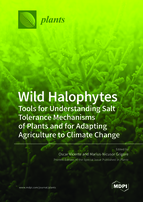Wild Halophytes: Tools for Understanding Salt Tolerance Mechanisms of Plants and for Adapting Agriculture to Climate Change
A special issue of Plants (ISSN 2223-7747). This special issue belongs to the section "Plant Response to Abiotic Stress and Climate Change".
Deadline for manuscript submissions: closed (20 February 2022) | Viewed by 39234
Special Issue Editors
Interests: climate change; plant biotechnology; plant reproduction; abiotic stress; plant stress physiology; halophytes; drought; salinity; stress tolerance; biostimulants
Special Issues, Collections and Topics in MDPI journals
Interests: halophytes; halophytes anatomy and ecology; ecophysiology of halophytes; plant abiotic stress; conceptual and historical approach of halophytes
Special Issues, Collections and Topics in MDPI journals
Special Issue Information
Dear Colleagues,
Climate change represents a major challenge for agriculture and food security in the coming years. Soil salinity is, together with drought, one of the major causes of the reduction of crop yields worldwide, and climate change is contributing to the increasing loss of irrigated cropland due to secondary salinization, especially in arid and semiarid regions. The most promising strategy to address this problem should be based on the genetic improvement of crop salt tolerance. This, in turn, requires a deep understanding of the mechanisms underlying salt tolerance. Paradoxically, most studies on plant salt tolerance have been carried out using non-tolerant model species, such as Arabidopsis thaliana. Besides, even though tolerance is based on a series of conserved responses to salt stress – control of ion transport, osmolyte biosynthesis, and activation of antioxidant systems – the specific mechanisms of tolerance can vary widely in different species. Therefore, no single model will provide enough information.
All major crops are glycophytes, sensitive to relatively low levels of salt in the soil. The halophytes, on the contrary, are adapted to natural saline environments and are able to survive and complete their life cycle in habitats with soil salinity equivalent to 200 mM NaCl, or even higher, close to that of seawater. Halophytes are, therefore, ideal materials for basic studies of salt tolerance mechanisms in plants, at the physiological, biochemical, and molecular levels. Apart from being a source of knowledge, halophytes can also provide biotechnological tools – salt-tolerance genes and salt-induced promoters – for the genetic improvement of salt tolerance of conventional crops. Furthermore, some halophytes could represent the basis of a sustainable ‘saline agriculture’, being commercially grown in salinized land and irrigated with brackish or saline water. This Special Issue will cover all of the aforementioned basic and applied aspects of halophytes research, reflected in original research articles, reviews, mini-reviews, and opinion papers.
Prof. Dr. Óscar Vicente
Dr. Marius-Nicusor Grigore
Guest Editors
Manuscript Submission Information
Manuscripts should be submitted online at www.mdpi.com by registering and logging in to this website. Once you are registered, click here to go to the submission form. Manuscripts can be submitted until the deadline. All submissions that pass pre-check are peer-reviewed. Accepted papers will be published continuously in the journal (as soon as accepted) and will be listed together on the special issue website. Research articles, review articles as well as short communications are invited. For planned papers, a title and short abstract (about 100 words) can be sent to the Editorial Office for announcement on this website.
Submitted manuscripts should not have been published previously, nor be under consideration for publication elsewhere (except conference proceedings papers). All manuscripts are thoroughly refereed through a single-blind peer-review process. A guide for authors and other relevant information for submission of manuscripts is available on the Instructions for Authors page. Plants is an international peer-reviewed open access semimonthly journal published by MDPI.
Please visit the Instructions for Authors page before submitting a manuscript. The Article Processing Charge (APC) for publication in this open access journal is 2700 CHF (Swiss Francs). Submitted papers should be well formatted and use good English. Authors may use MDPI's English editing service prior to publication or during author revisions.
Keywords
- abiotic stress
- antioxidant systems
- climate change
- ion transport
- osmolyte accumulation
- plant breeding
- saline agriculture
- salinity
- salt stress responses
- salt tolerance








